Contents
of the Summer 2008 Northants News
|
Three
(more) first-timers
Trevor Wray |
I wrote an article for NN on
three plants that flowered for the first time way back in 1991. Obviously since
then there have been many more though mostly of the kind that would not cause
great excitement here. After all, when you buy a plant of the Rebutia group you
expect it to flower every Spring. A Mammillaria that didn’t perform
would be out on its ear!
|
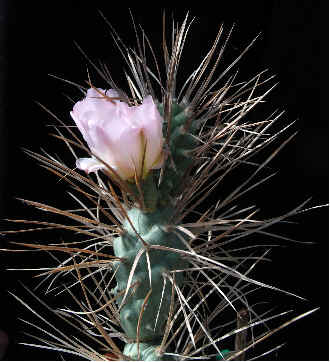
|
The first of this group is
a plant I have labelled as Opuntia diademata and before I could
write about this I had a problem. When I reached for my CITES checklist
the species wasn’t listed. How could I check the spelling and see if
this was a currently accepted name? Same in the New Lexicon. Strange, very
strange…
Luckily I have been a
contributor to Bradleya for the last 25 years (happy birthday!) and
luckily Roy Mottram and Richard Crook wrote an Index of all the names that
were vaguely connected with Opuntia. Not the most exciting read (unless
you have insomnia) but a useful reference. I reached for the C to D
episode of 1996. ”See articulata diademata”. |
I reached for the A to Bs of
1995. It seems Lemaire described Opuntia diademata in 1838, then
reclassified it as a Tephrocactus in 1868, (when the ending changed to ‘–us’).
This was a name with some history; I should never look again at that plant
without great respect! Backeberg changed it to a variety of T. articulatus
in 1953. Then Kiesling referred the plant to Opuntia articulata var. oligacantha
and at least the articulata was in the CITES checklist. I will naturally
keep the label O. diademata on my plant.
So, back to flowers. I acquired Opuntia
diademata as a single joint a dozen years ago. I was aware that it was of
the Tephrocactus persuasion so wasn’t expecting flowers. These days I know
that many of this kind flower as regularly as my Rebutias. The joint filled out
and after a bit, each year it grew just one new one on top. Looking decided
wobbly I placed some canes to support the stem. Then in July it flowered from
the second from top joint. It was a complete surprise, the bud had developed
round the far side. I never got to see the flower fully open, (working days and
dismal weather), so the picture is the best I can do. Looks like a Tephrocactus
articulatus flower? Oh, all right. Bad news was that moving the plant for
the photographic record snapped the stem near the base, good news is I will be
able to propagate this novelty from cuttings.
|
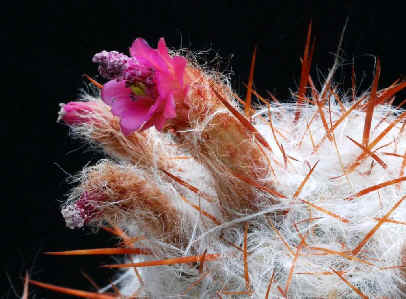
|
My second contender is a plant of
Oreocereus trollii I have had for over thirty years. It is a nice clone
with lots of wool and stout red nails poking out. Years ago the central head was
looking rather tired and I cut it out to grow on three offsets. A fourth offset
was rooted and potted separately. Neither of these plants have flowered before.
I was amazed when I saw there were three buds at the apex of one of the stems
and followed the development with some interest. |
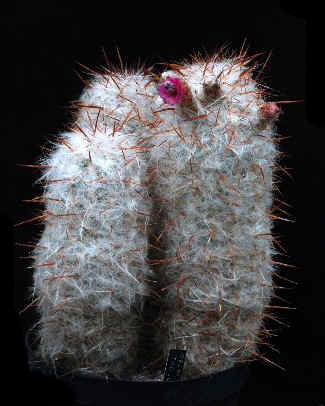
|
Over a few days I was able to
take some reasonable pictures. All cacti eventually reach a size or maturity to
flower but whether this is a one-off due to last year’s exceptional weather or
I will have a repeat performance every year, only time will tell.
My problem as
I write this is our annual show is a fortnight away and should I remove the
spent flowers from the plant? Or leave them there to proudly say, ‘I did it, I
flowered an Oreocereus at last!
My final offering is very
different from the previous and not just because it is one of the other
succulents. Echeveria nodulosa is a common plant that is easy to grow but
only recently acquired here. It came, un-named, at a stall in the ‘Garden Open
Day’ scheme and was a quid for charity well spent. It wasn’t worth two quid
because it was crawling with mealies. A squirt of Imidacloprid, (Provado to
you), between the eyes soon dealt with that! I thought it would have some merit
as a summer patio plant with the Mexican Sedums.
|
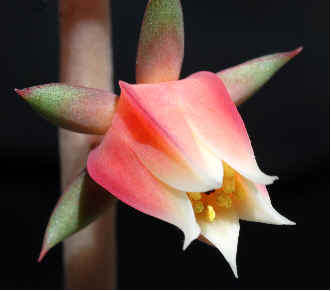
|
I noticed the early development
of flowers and watched the stem extend. Some Echeverias have attractive flowers
but I wasn’t sure what I was going to see with this one. Well, as a spectacle
it was a bit of a disappointment but a close look at the individual flowers show
that they are rather fancy. After a look at Walther’s ‘Echeverias’ an even
closer look at the flowers with a hand-lens showed that, yes, they were minutely
papillose (posh word for having nipple-like growths). In fact all parts of this
species have papillae. Having snapped the pictures I snapped the flower stems
off. OK… they are OK, but not that OK. Nodulosa ought to concentrate on
growing some more of those really attractive leaves. |
P.S. The problem of the spent
flowers on my Oreocereus solved itself; shortly a fruit developed so I could
hardly pull that off.
Trev
|
Echeveria
'Frank Reinhelt Trevor
Wray |
 |
I first met Echeveria
‘Frank Reinhelt’ at a Birmingham Show and I was impressed. It was a
single-headed, green plant suffused through with red and obviously had a
lot to do with Echeveria agavoides. Shortly after I bought a plant
named Echeveria agavoides x lindsayana which had to be the
same hybrid. Both parents are attractive species and the mix had the same
red coloration I admired.
|
E.
‘Frank Reinhelt’ was introduced as ISI 1467 in 1984. The official parents of
the cross were then given as E. agavoides var. prolifera and E.
colorata (the present ‘correct’ name for E. lindsayana.) From the
internet I learnt that E. ‘Frank Reinhelt’ was awarded an Award of
Merit by the RHS in 1993 along with several other species and cultivars. Frank
Reinhelt himself was an Echeveria hybridiser of Capitola, California who also
introduced ‘Black Prince’. There is an attractive Graptopetalum ‘Frank
Reinhelt’ as well.
|
E. ‘Frank Reinhelt’ is not
a common plant around our parts. It does not branch quickly and when I
tried a few leaves they rotted while I looked at them. Many Echeverias
will grow from the detached leaves on the flowering stem so I will try
these. Meanwhile I was pleased to see some plants for sale at B&Q just
before last Christmas. Like mine they had the intense red that develops
especially in autumn and winter, though these were even better. What extra
light intensity could they manage in Holland? (Or China?) But then I
looked again, it wasn’t quite the ‘plastic cactus’ or the ‘Helichrysum
flowers’, but the red colour we admire had been sprayed on. This was a
fraud! Will the customer who buys a red Christmas decoration discard it in
the New Year when new growth on a windowsill is apple-green? Will the
Trading Standards people pounce? I don’t know, but properly grown
Echeveria ‘Frank Reinhelt’ is a delight.
Trev |
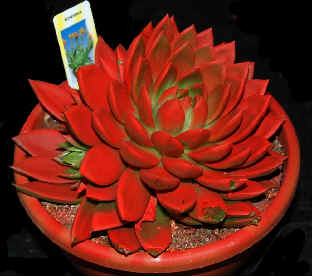
|






